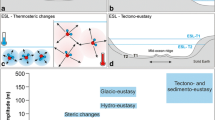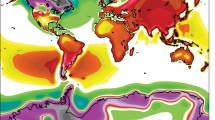Summary
Results of a calculation of the spectrum of eigenoscillations, spatial structure and energy characteristics of the M2-tidal wave in the paleocean for nine periods of the Phanerozoic are discussed. It has been shown that consolidation of the continents causes attenuation of the semi-diurnal and amplification of the diurnal eigenoscillations and vice versa, isolation of the continents contributes to amplification of the semi-diurnal oscillations and attenuation of the diurnal ones. Changes in the resonant properties of the World Ocean result in a reconstruction of spatial structure of the tides and in evolution of the tidal energy dissipation. As it retreats to the past, the tidal energy dissipation first decreases and then, beginning from the period between the Late Carboniferous — Early Permian, increases reaching its maximum in the Early Cambrian.
Zusammenfassung
Es werden die Ergebnisse einer Berechnung des Spektrums der Eigenschwingungen, der räumlichen Struktur und der Energieverteilung der M2-Tide im Paläo-Ozean für neuen Perioden des Phanerozoikums diskutiert. Es konnte gezeigt werden: Die Verdichtung der Kontinente führte zu einer Schwächung der halbtätigen und Verstärkung der eintägigen Eigenschwingungen, die Trennung der Kontinente führte dagegen zur Vergrößerung der halbtätigen und Verringerung der ganztägigen Schwingungen. Änderungen in den Resonanzeigenschaften des Weltozeans beruhen auf einer Änderung der räumlichen Struktur der Gezeiten und auf der Entwicklung der Vernichtung der Gezeitenenergie. DAvor nahm die Vernichtung der Gezeitenenergie zuerst ab und dann, beginnend in der Periode zwischen spätem Karbon und frühem Perm, wuchs sie und erreichte ihr Maximum im frühen Kambrium.
Résumé
Les résultats d'un calcul du spectre des ondes propres, de la structure spatiale et des caractéristiques énergétiques de l'onde de marée M2 dans le Paleo-ocean sont étudiés pendant neuf périodes du Phanérozoïque. Il a été montré que la densification des continents provoque une atténuation de l'onde semi-diurne et une amplification de l'onde diurne et inversement la séparation des continents contribue à l'amplification de l'onde semi-diurne et à l'affaiblissement de l'onde diurne. Les modifications des propriétés de résonance de l'océan mondial résultent d'un changement de la structure spatiale des marées et de l'évolution de la dissipation de l'énergie des marées. En remontant dans le temps, la dissipation de l'énergie des marées décroît d'abord, puis à partir du début de la période Carbonifère supérieur — Permien inférieur croît et atteint son maximum pendant le Cambrien inférieur.
Similar content being viewed by others
References
Accad, Y., and C. L. Pekeris, 1978: Solution of the tidal equations for the M2 and S2 tides in the World Ocean from a knowledge of the tidal potential alone. Philos. Trans. r. Soc. (A)290, 235–266.
Brosche, P., and W. Hövel, 1982: Tidal friction for times around the presence. In: Tidal friction and the earth's rotation. Proc. of a workshop held at the Centre for Interdisciplinary Research (ZiF) of the Univ. of Bielefeld, Sept. 28–Oct. 3, 1981. Berlin, Heidelberg [usw.]: Springer.2, 175–189.
Estes, R. H., 1977: A computer software system for the generation of global ocean tides including self-gravitation and crustal loading effects. Final report. Techn. Rep. Business and Technol. Syst. TR-77-41, p. 60.
Grodeev, R. G., B. A. Kagan, and E. V. Polyakov, 1977: The effects of loading and self-attraction on global ocean tides. The model and the results of a numerical experiment. J. phys. Oceanogr.7, 161–170.
Gotlib, V. Yu., and B. A. Kagan, 1980: Resonance periods of the World Ocean. Dokl. Akad. Nauk SSSR.252, 725–728.
Gotlib, V. Yu., and B. A. Kagan, 1981: Numerical simulation of tides in the World Ocean. 1. Parameterization of the shelf effects. Dt. hydrogr. Z.34, 273–283.
Gotlib, V. Yu., and B. A. Kagan, 1982 a: Numerical simulation of tides in the World Ocean. 2. Experiments of the sensitivity of the solution to choice of the shelf effect parameterization and to variations in shelf parameters. Dt. hydrogr. Z.35, 1–14.
Gotlib, V. Yu., and B. A. Kagan, 1982 b: Numerical simulation of tides in the World Ocean. 3. A solution to the spectral problem. Dt. hydrogr. Z.35, 45–58.
Hansen, K. S., 1982: Secular effects of oceanic tidal dissipation on the moon's orbit and the earth's rotation. Rev. Geophys. Space Phys.20, 457–480.
Hendershott, M. C., 1977: Numerical models of ocean tides. In: The Sea. Ideas and observations on progress in the study of the seas.6, 47–95. New York: Wiley.
Kagan, B. A., 1985: On the relationship between astronomical and geophysical estimates of the tidal energy dissipation. Okeanologia.25, 373–377.
Krohn, J., P. Brosche, and J. Sündermann, 1981: Palagezeiten und erdrotation. Geol. Rundschau.70, 64–77.
Krohn, J., and J. Sündermann, 1982: Paleotides before the Permian. In: Tidal friction and the earth's rotation. Proc. of a workshop held at the Centre for Interdisciplinary Research (ZiF) of the Univ. of Bielefeld, Sept. 28–Oct. 3, 1981. Berlin, Heidelberg [usw.]: Springer.3, 190–209.
Lambeck, K., 1977: Tidal dissipation in the oceans: Astronomical, geophysical and oceanographic consequences. Philos. Trans. r. Soc. (A)287, 545–593.
Lambeck, K., 1980: The earth's variable rotation: Geophysical causes and consequences. Cambridge: Cambridge Univ. Press. 449 p.
Marčuk, G. I., and B. A. Kagan, 1983: Dynamics of the ocean tides. Leningrad: Gidrometeoizdat. 359 p.
Monin, A. S., and Yu. A. Shishkov, 1979: The history of climate. Leningrad: Gidrometeoizdat. 407 p.
Munk, W. H., 1968: Once again — tidal friction. Quart. J. R. astronom. Soc.9, 352–375.
Platzman, G. W., G. A. Curtis, K. S. Hansen et al., 1981: Normal modes of the World Ocean. 2. Description of modes in the period range 8 to 80 hours. J. phys. Oceanogr.11, 579–600.
Proudman, J., 1941: The effect of coastal friction on the tides. Monthly Notices R. Astronom. Soc., Geophys. Suppl.5, 23–26.
Schopf, T. J. M., 1980: Paleoceanography. Harward Univ. Press. 341 S.
Schwiderski, E. W., 1979–1981: Global ocean tides. Parts 2–9. Atlas of tidal charts and maps. Dahlgren, Virg.: Naval Surface Weapons Center. (Techn. Rep. Naval Surface Weapons Center.)
Schwiderski, E. W., 1980: Ocean tides. P. 2. A hydrodynamical interpolation model. Mar. Geod.3, 219–255.
Sündermann, J., 1982: The resonance behavior of the World Ocean. In: Tidal friction and the earth's rotation. Proc. of a workshop held at the Centre for Interdisciplinary Research (ZiF) of the Univ. of Bielefeld, Sept. 28–Oct. 3, 1981. Berlin, Heidelberg [usw.]: Springer.2, 165–174.
Sündermann, J., and P. Brosche, 1978: The numerical computation of tidal friction for Present and Ancient Ocean. In: Tidal friction and the earth's rotation. Proc. of a workshop held at the Centre for Interdisciplinary Research (ZiF) of the Univ. of Bielefeld, Sept. 26–30, 1977. Berlin, Heidelberg [usw.]: Springer.1, 125–144.
Webb, D. J., 1982: Tides and the evolution of the earth-moon system. Geophys. J. R. astronom. Soc.70, 261–271.
Ziegler, A. M., C. R. Scotese, and S. F. Barnett, 1982: Mesozoic and Cenozoic paleogeographic maps. In: Tidal friction and the earth's rotation. Proc. of a workshop held at the Centre for Interdisciplinary Research (ZiF) of the Univ. of Bielefeld, Sept. 28–Oct. 3, 1981. Berlin, Heidelberg [usw.]: Springer.2, 240–252.
Author information
Authors and Affiliations
Rights and permissions
About this article
Cite this article
Gotlib, V.Y., Kagan, B.A. A reconstruction of the tides in the paleocean: Results of a numerical simulation. Deutsche Hydrographische Zeitschrift 38, 43–67 (1985). https://doi.org/10.1007/BF02226669
Received:
Accepted:
Published:
Issue Date:
DOI: https://doi.org/10.1007/BF02226669




